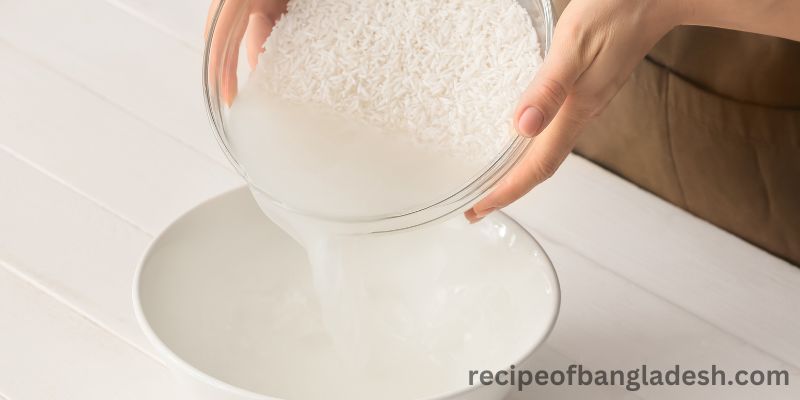White rice is a staple food for many people around the world, and soaking it prior to cooking can have many benefits. Soaking the rice helps to improve its texture, making the grains softer and less sticky.
It also helps to reduce the cooking time and increase the nutritional value of the finished product. But, how long can you soak white rice for?
The recommended soaking time for white rice will vary depending on the variety of rice, the desired texture, and the cooking method. Generally, white rice should be soaked for at least 30 minutes and up to 4 hours.
It’s recommended to consult the instructions on the rice package or a trusted recipe for guidance on the best soaking time for your specific needs.
However, it’s important to avoid soaking the rice for too long, as this can increase the risk of spoilage and decrease its nutritional value. By following recommended soaking times, you can maximize the benefits of soaking while minimizing the risks.

Importance of Soaking White Rice
White rice, especially long-grain varieties, can benefit greatly from soaking. This is because the grains tend to be harder and can take longer to cook through. By soaking the rice before cooking, the grains can absorb some of the water, making them softer and more pliable.
As a result, the rice will cook more evenly, reducing the risk of under- or over-cooking and resulting in a better final product. Soaking also has the added benefit of increasing the nutritional value of the rice, as some vitamins and minerals can be released into the soaking water.
How long can I soak white rice?
The time required for soaking white rice can vary based on several factors, including the variety of rice, the desired texture, and the cooking method. Longer grains of rice, such as Basmati, tend to require a longer soaking time, while shorter grains, such as Arborio, may need a shorter soaking time.
The desired texture of the finished product can also impact the soaking time, with longer soaking times resulting in softer, more pliable grains and shorter soaking times producing firmer, more distinct grains.
Generally, white rice should be soaked for at least 30 minutes and up to several hours, depending on the desired texture and cooking method. For example, for steaming, a 30-minute soak may be sufficient, while for boiling, a longer soak of 1-2 hours may be necessary.
It’s recommended to experiment with different soaking times to determine what works best for your specific cooking method and desired texture. When in doubt, consult the instructions on the rice package or consult a trusted recipe for guidance.
Benefits of Soaking White Rice
Improved Texture and Taste
Soaking white rice prior to cooking can result in a noticeable improvement in the texture and taste of the finished product. The grains will be softer, fluffier, and less sticky, resulting in a more enjoyable eating experience.
Additionally, the flavors of seasonings and sauces will be more pronounced, as the softer grains will absorb them more readily.
Reduced Cooking Time
By soaking white rice, the cooking time can be significantly reduced. This is because the grains have absorbed some of the water, making them more pliable and easier to cook through. As a result, the cooking process is faster and more efficient, making it easier to prepare a delicious meal in a shorter amount of time.
Increased Nutritional Value
Soaking white rice has the added benefit of increasing its nutritional value. By absorbing water, the rice will release some of its vitamins and minerals, making them more available for absorption by the body.
Additionally, soaking can also help to break down some of the rice’s natural phytic acid, which can interfere with the absorption of certain nutrients. The end result is a more nutritious finished product that provides a greater array of essential vitamins and minerals.
Risks of Soaking White Rice for Too Long
Increased Risk of Spoilage
While soaking white rice can be beneficial, soaking it for too long can have negative consequences. One of the primary risks of soaking rice for an extended period of time is the increased risk of spoilage.
As the rice absorbs water, it becomes a breeding ground for bacteria and other microorganisms, which can cause the rice to spoil and become inedible. To avoid this, it’s important to store soaked rice in the refrigerator and to avoid soaking it for more than 4 hours.
Decreased Nutritional Value
Another risk of soaking white rice for too long is that it can decrease its overall nutritional value. As the rice continues to absorb water, it can release more of its vitamins and minerals, reducing the overall nutritional content of the finished product.
Additionally, prolonged soaking can also break down some of the rice’s natural antioxidants, further reducing its nutritional value. To minimize these risks, it’s important to follow recommended soaking times and to store soaked rice in the refrigerator to slow down the degradation of its nutrients.
Final Thoughts
The recommended soaking time for white rice will vary based on the variety of rice, the desired texture, and the cooking method. Generally, white rice should be soaked for at least 30 minutes and up to several hours, depending on the desired texture and cooking method.
Soaking white rice can provide a range of benefits, but it’s important to balance these benefits against the risks of soaking for too long.
By following my recommended soaking times, storing soaked rice in the refrigerator, and taking care to avoid spoilage, it’s possible to maximize the benefits of soaking while minimizing the risks. Soaking white rice can be a valuable step in the preparation of this staple food, resulting in a better-tasting and more nutritious finished product.

Leave a Reply